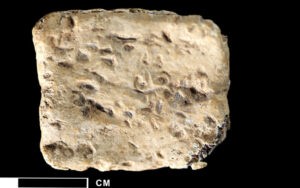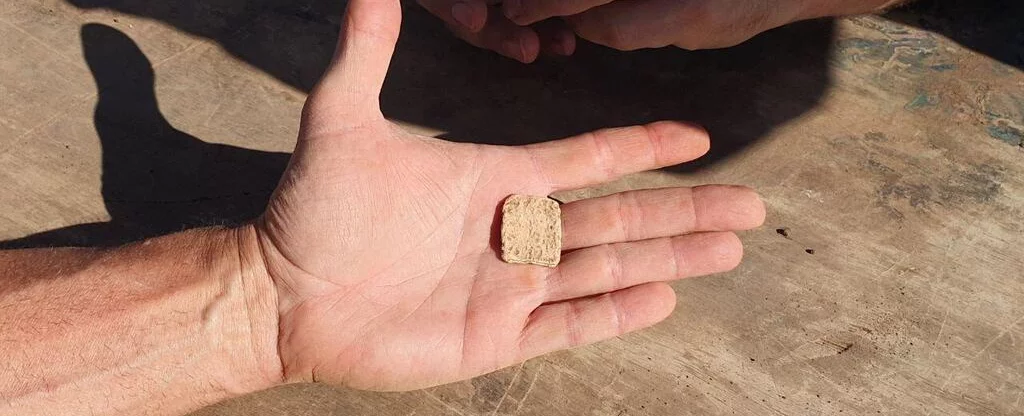Have you heard about the Mount Ebal inscription?
It has excited a diverse group of individuals. From the nerdiest of the nerds who get lit about new ancient inscriptions to evangelical apologists who are enthusiastic when archaeology seems to corroborate the Bible, people are talking. And, with good reason.
On March 24, Scott Stripling, director of the Archaeological Studies Institute at The Bible Seminary in Katy, Texas, announced in a televised press conference that his international team of excavators had discovered a Late Bronze Age (14th to 13th century BCE) inscription on Mount Ebal. The inscription is on a lead tablet, is about 2 by 2 centimeters and appears to have been written in proto-Canaanite script. The excavator claims the inscription says:

The tiny inscription from Mount Ebal
Cursed, cursed, cursed — cursed by the God YHW.
You will die cursed.
Cursed you will surely die.
Cursed by YHW — cursed, cursed, cursed.
If the inscription is everything the excavators claim, here are the reasons this find is amazing:
- If it really is from the Late Bronze Age, it is the oldest inscription of its kind that we have.
- Proto-Canaanite is a precursor to Hebrew (the language of the Old Testament/Hebrew Bible). This might be evidence that people could write in a script that led to Hebrew (among other languages) at this very early date.
- The tablet contains the letters “YHW” which together are fairly similar to the Hebrew letters “YHWH,” which represents one of the names of God in the Old Testament/Hebrew Bible (often translated into English as the LORD).
- Mount Ebal is mentioned in Deuteronomy 11:29 as the place the Israelites should proclaim the curses of their covenant with YHWH (which they do in Joshua 8:33). A curse tablet on that very mountain in a script that led to Hebrew is a very interesting confluence of factors.
However, the inscription might not be everything the excavators claim. Here are some reasons to be cautious:
- The tablet was found in a sifting operation. The excavators were sifting through the dump site of a previous excavation. When excavators find things outside their original context, it is much harder to be sure of the date from which they came. If someone digs up a single time capsule dated to 1951, it is likely safe to assume the items inside are from 1951. However, if someone is at a dump and finds time capsules from 1951, 1972 and 2016 all broken open and mixed together, it will be much harder to discern what period the items are from.
- Experts are skeptical. So many factors go into the process of deciphering an ancient text like this. Written language still was evolving at the time, so while one expert might think they have found the word “curse,” another might suggest it says “flee.”
- We don’t have any peer-reviewed analysis of the find or any high-resolution photos. Other archaeologists need to weigh in to determine if the find is legitimate.
- The excavation was conducted in Palestinian territory and doesn’t seem to have been carried out under a permit. The inscription was analyzed in the Czech Republic, and archaeological standards include strict rules about removing finds from their place of origin. Although it is clear the excavators do not think they have done anything wrong, others have questioned the legitimacy of an excavation without a permit.
So, we might have a ground-breaking discovery on our hands, or we might not. Time will tell.
For now it seems prudent not to get swept up in the hype. In his presentation concerning the find, lead excavator Scott Stripling said that the inscription is “a challenge to the theory that states that Moses could not have written the Pentateuch because an alphabetic script did not exist early enough. Here we see that it did exist.”
It is true that such an early script would challenge that one aspect of why scholars think Moses could not have written the Pentateuch. However, if you are looking for proof that Moses did write the Pentateuch, this find is not your smoking gun. Scholars hang their suspicions about Mosaic authorship on more than one peg.
“If you are looking for proof that Moses did write the Pentateuch, this find is not your smoking gun.”
Christian apologists are eager to point to the find as evidence that the Bible is just what they always thought it was — a history/science book that tells stories the way Westerners in the modern era would. A conservative website, “Not the Bee” glibly title its article on the find “An ancient lead tablet with a 3,500-year-old Hebrew curse shows the Bible is ‘hundreds of years older than scholars previously thought’ … or just as old as anyone who actually read the Bible thought.”
If the inscription is all the excavators claim, it has a total of 40 letters on it but the word “curse (‘rr)” occurs 10 times accounting for 30 of the 40 letters. At best, we have evidence that someone in the Late Bronze Age could write around 12 letters. The Old Testament/Hebrew Bible has more than 12 letters.
A TikToker uploaded a video in which he talked about the inscription as possible proof that Moses wrote the Pentateuch and that the narrative of the Exodus and the conquest under Joshua “really did happen as the Bible describes.” He takes “liberal” scholars to task because they think (according to him) Moses didn’t exist and that the “Jews made up Moses and the Old Testament stories around 586 BC.”
Scholars, in fact, have a variety of views concerning the historicity of Moses, and I know of none who would say the Old Testament stories were “made up.”
You won’t be surprised to hear that I think all this is an over-reach. At its best, the inscription is a very early example of proto-Canaanite script with our earliest mention of the Israelite deity, YHWH. This liberal scholar thinks that would be amazing. The inscription cannot carry the weight of proving Mosaic authorship of the Pentateuch or the historicity of any biblical texts. At its worst, the inscription is an overhyped finding that is not that early, not Hebrew and does not have the Hebrew name for God. I will keep watching to find out.

Anna Sieges
Anna Sieges serves as associate professor of religion at Gardner-Webb University in Boiling Springs, N.C. She loves shopping, discussing the Bible and romantic comedies.
Related articles
Desire to validate the Bible makes Christians easy prey for archaeological forgeries | Analysis by Rick Pidcock


